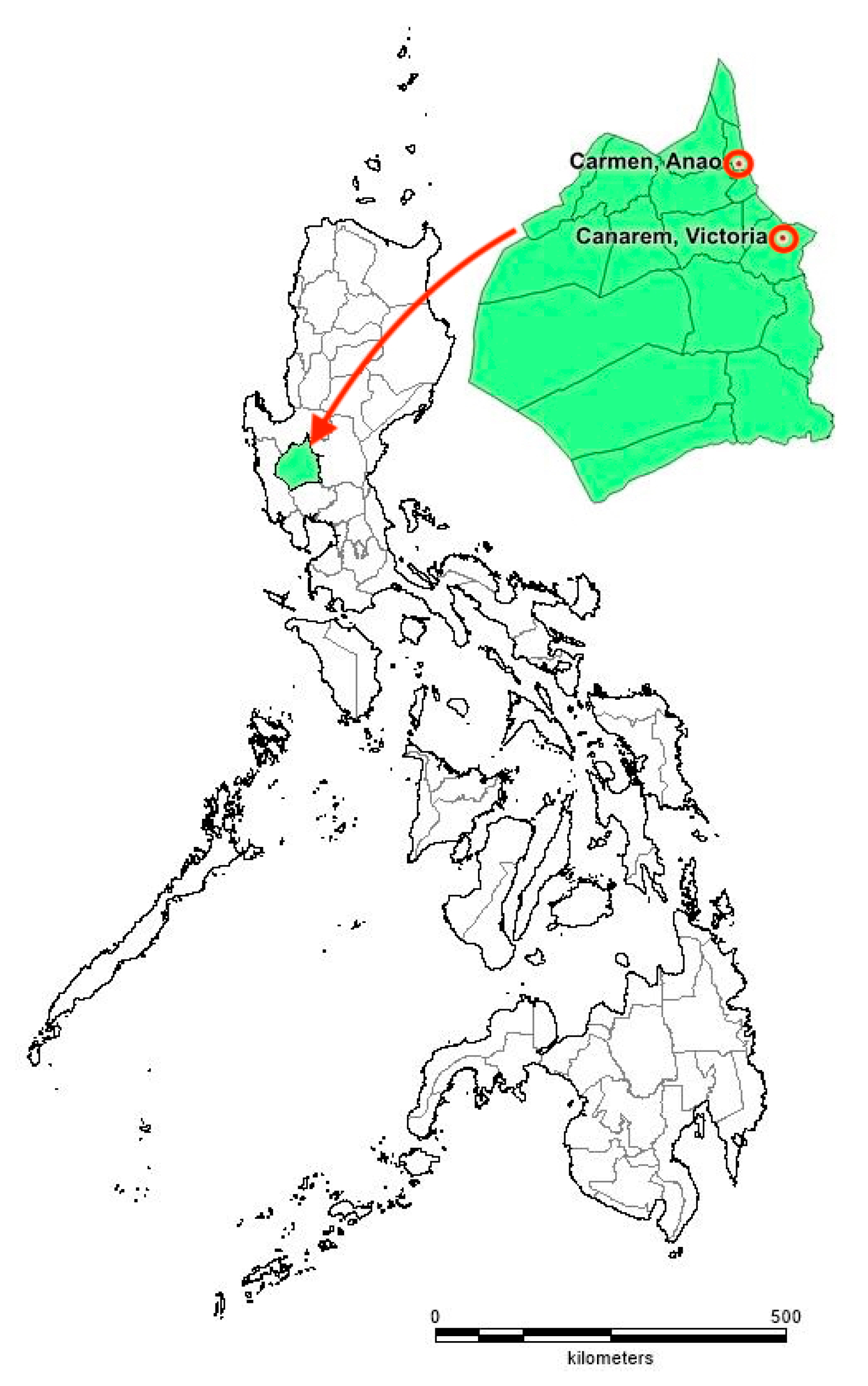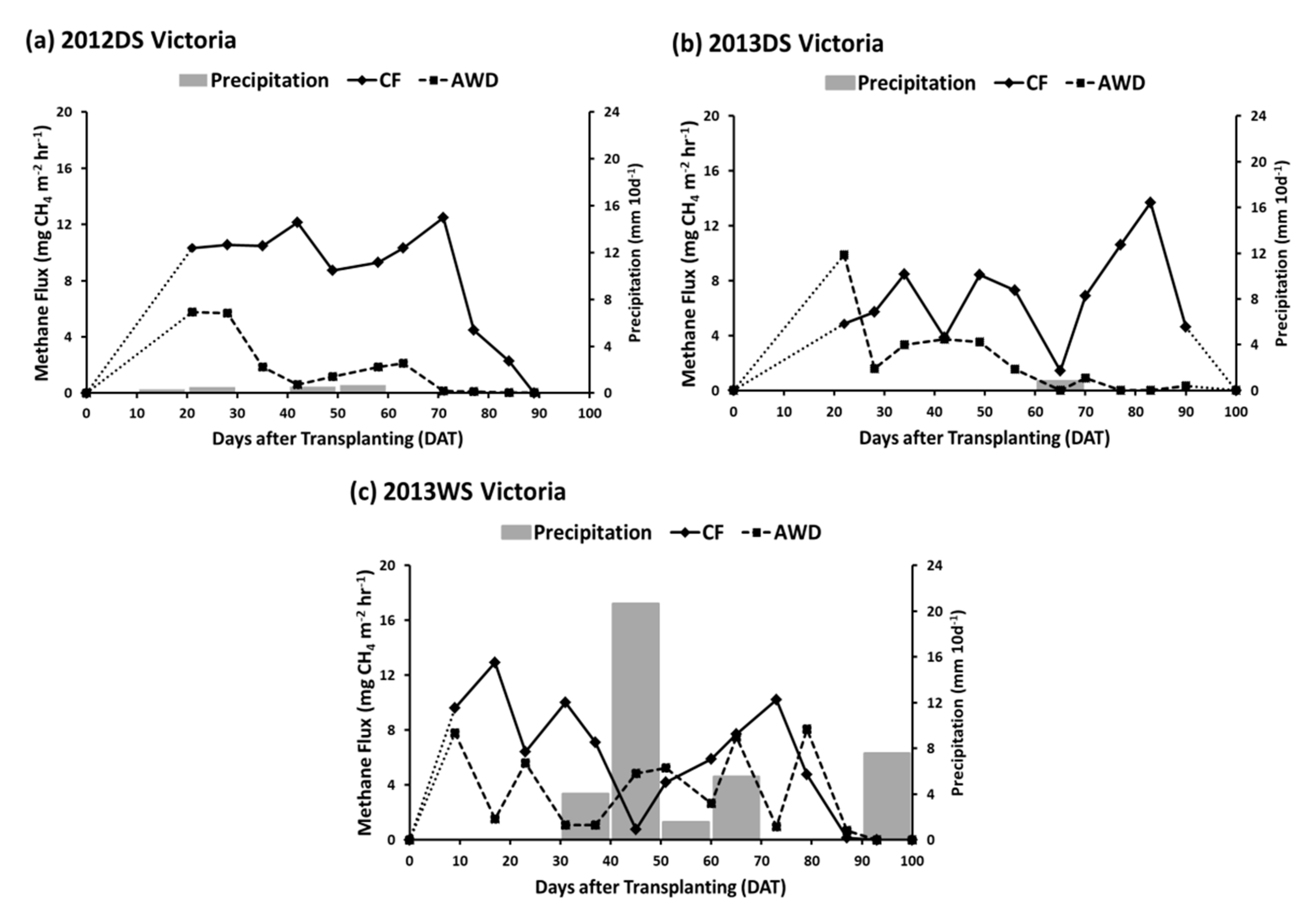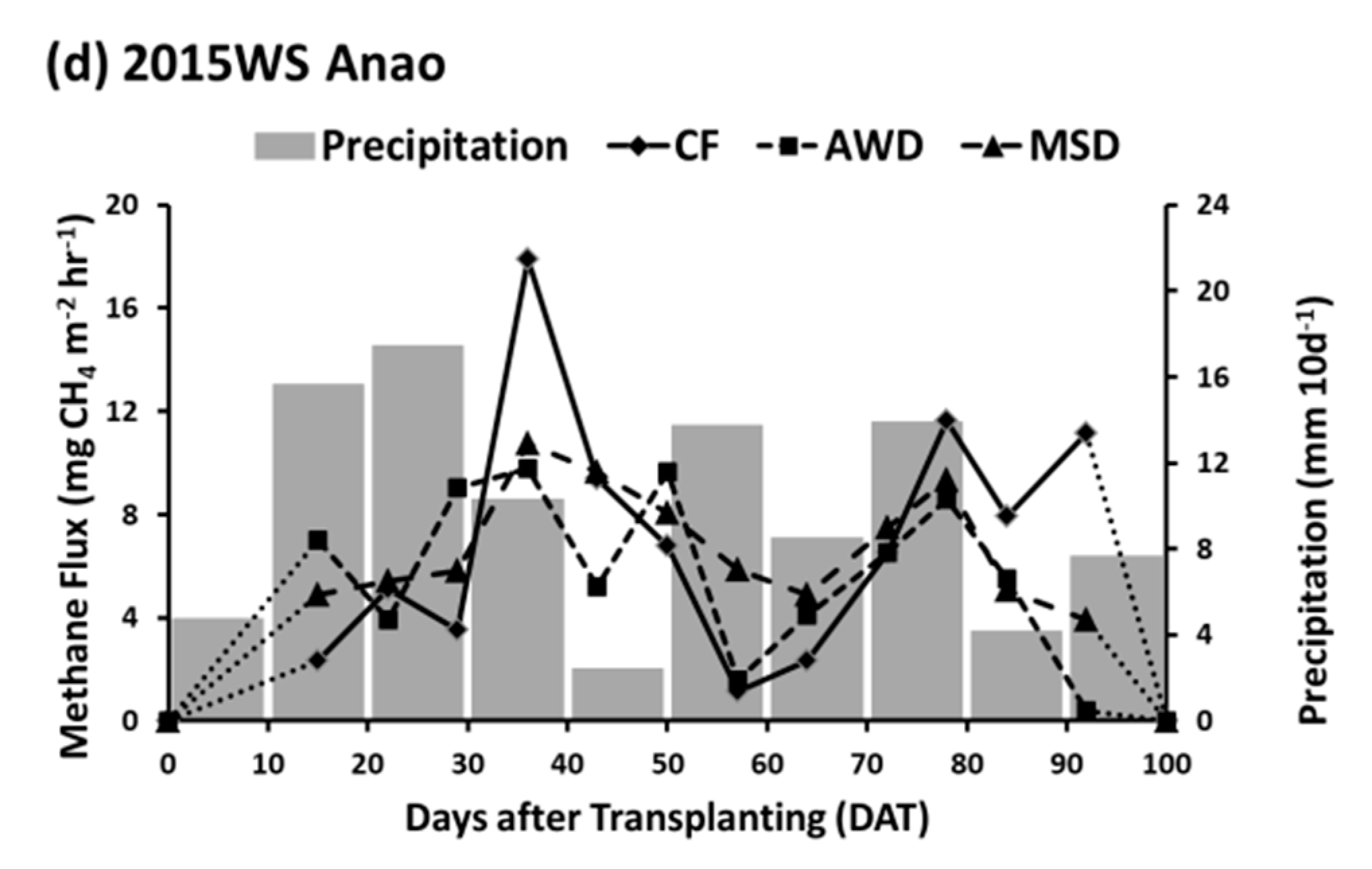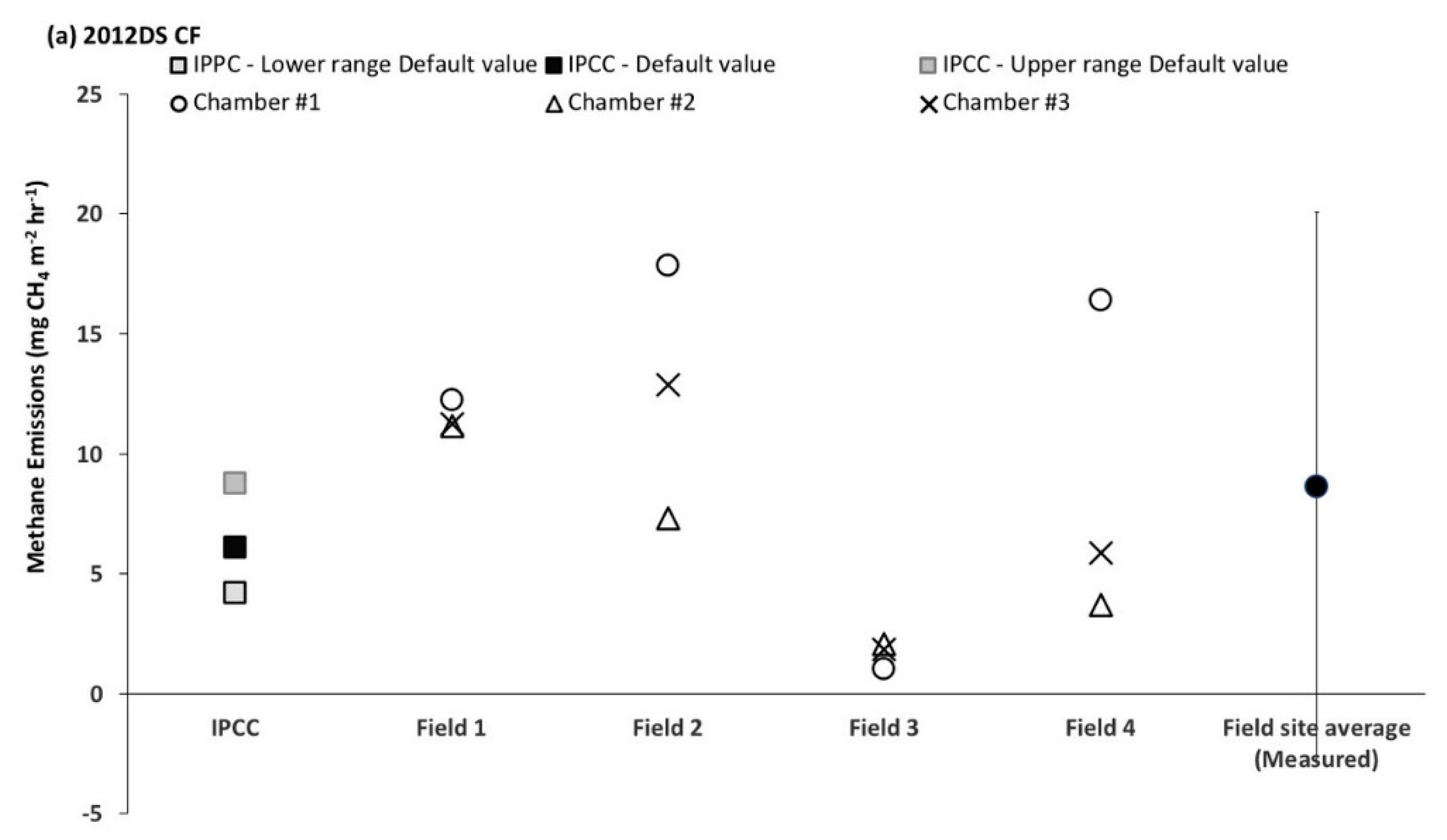Potential of Alternate Wetting and Drying Irrigation Practices for the Mitigation of GHG Emissions from Rice Fields: Two Cases in Central Luzon (Philippines)
Abstract
1. Introduction
- Support the establishment of a baseline data of emissions under continuous flooding;
- Assess the mitigation effect of AWD under farmers’ field conditions; and
- Evaluate the feasibility and efficiency of AWD in Central Luzon.
2. Materials and Methods
2.1. Site Description
2.2. Irrigation
2.3. Gas Sampling and Analysis
2.4. Calculation of Daily and Seasonal Emissions
2.5. Grain Yield
2.6. Statistical Analysis
3. Results
3.1. Seasonal Patterns of CH4 Emissions
3.2. N2O Emissions
3.3. Seasonal Cumulative GHG Emissions and GWP
4. Discussion
5. Conclusions
Supplementary Materials
Author Contributions
Funding
Acknowledgments
Conflicts of Interest
References
- Smith, P.; Bustamante, M.; Ahammad, H.; Clark, H.; Dong, H.; Elsiddig, E.A.; Haberl, H.; Harper, R.; House, J.; Jafari, M.; et al. Agriculture, Forestry and Other Land Use (AFOLU). In Climate Change 2014: Mitigation of Climate Change; Edenhofer, O., Pichs-Madruga, R., Sokona, Y., Farahani, E., Kadner, S., Seyboth, K., Adler, A., Eds.; IPCC Working Group III Contribution to AR5; Cambridge University Press: Cambridge, UK, 2014; pp. 811–922. [Google Scholar]
- Global Rice Science Partnership (GRiSP). Rice Almanac; International Rice Research Institute: Los Baños, Laguna, Philippines, 2013; p. 283. [Google Scholar] [CrossRef]
- Denman, K.; Brasseur, G.; Chidthaisong, A.; Ciais, P.; Cox, P.M.; Dickinson, R.E.; Hauglustaine, D.; Heinze, C.; Holland, E.; Jacob, D.; et al. Couplings Between Changes in the Climate System and Biogeochemistry. In Climate Change 2007: The Physical Science BasisContribution of Working Group I to the Fourth Assessment Report of the Intergovernmental Panel on Climate Change; Solomon, S., Qin, D., Manning, M., Chen, Z., Marquis, M., Averyt, K.B., Tignor, M., Miller, H.L., Eds.; Cambridge University Press: Cambridge, UK, 2007. [Google Scholar]
- Epule, E.T.; Peng, C.; Mafany, N.M. Methane emissions from paddy rice fields: Strategies Towards Achieving A Win-Win Sustainability Scenario Between Rice Production and Methane Emission Reduction. J. Sustain. Dev. 2011, 4, 188–196. [Google Scholar] [CrossRef]
- Schuetz, H.; Seiler, W.; Conrad, R. Processes involved in formation and emission of methane in rice paddies. Biogeochemistry 1989, 7, 33–53. [Google Scholar] [CrossRef]
- Cai, Z.; Xing, G.; Yan, X.; Xu, H.; Tsuruta, H.; Yagi, K.; Minami, K. Methane and nitrous oxide emissions from rice paddy fields as affected by nitrogen fertilisers and water management. Plant Soil 1997, 196, 7–14. [Google Scholar] [CrossRef]
- Myhre, G.; Shindell, D.; Bréon, F.-M.; Collins, W.; Fuglestvedt, J.; Huang, J.; Koch, D.; Lamarque, J.-F.; Lee, D.; Mendoza, B.; et al. Anthropogenic and Natural Radiative Forcing. In Climate Change 2013: The Physical Science Basis Contribution of Working Group I to the Fifth Assessment Report of the Intergovernmental Panel on Climate Change; Cambridge University Press: Cambridge, UK, 2013; pp. 659–740. [Google Scholar] [CrossRef]
- FAO. AQUASTAT Main Database, Food and Agriculture Organization of the United Nations (FAO). Available online: http://www.fao.org/aquastat (accessed on 29 October 2018).
- Siopongco, J.D.L.C.; Wassmann, R.; Sander, B.O. Alternate wetting and drying in Philippine rice production: Feasibility study for a Clean Development Mechanism. Tech. Bull. 2013, 17, 14. [Google Scholar]
- Bouman, B.A.M.; Tuong, T.P. Field water management to save water and increase its productivity in irrigated lowland rice. Agric. Water Manag. 2001, 49, 11–30. [Google Scholar] [CrossRef]
- Feng, L.; Bouman, B.A.M.; Tuong, T.P.; Cabangon, R.J.; Li, Y.; Lu, G.; Feng, Y. Exploring options to grow rice using less water in northern China using a modelling approach. I. Field experiments and model evaluation. Agric. Water Manag. 2007, 88, 1–13. [Google Scholar] [CrossRef]
- Cabangon, R.J.; Tuong, T.P.; Castillo, E.G.; Bao, L.X.; Lu, G.; Wang, G.; Cui, Y.; Bouman, B.; Li, Y.; Chen, C.; et al. Effect of irrigation method and N-fertilizer management on rice yield, water productivity and nutrient-use efficiencies in typical lowland rice conditions in China. Paddy Water Environ. 2004, 2, 195–206. [Google Scholar] [CrossRef]
- Carrijo, D.R.; Lundy, M.E.; Linquist, B.A. Rice yields and water use under alternate wetting and drying irrigation: A meta-analysis. Field Crop. Res. 2017, 203, 173–180. [Google Scholar] [CrossRef]
- Yan, X.; Yagi, K.; Akiyama, H.; Akimoto, H. Statistical analysis of the major variables controlling methane emission from rice fields. Glob. Chang. Biol. 2005, 11, 1131–1141. [Google Scholar] [CrossRef]
- Schleussner, C.F.; Rogelj, J.; Schaeffer, M.; Lissner, T.; Licker, R.; Fischer, E.M.; Knutti, R.; Levermann, A.; Frieler, K.; Hare, W. Science and policy characteristics of the Paris Agreement temperature goal. Nat. Clim. Chang. 2016, 6, 827–835. [Google Scholar] [CrossRef]
- Lu, W.F.; Chen, W.; Duan, B.W.; Guo, W.M.; Lu, Y.; Lantin, R.S.; Wassmann, R.; Neue, H.U. Methane emissions and mitigation options in irrigated rice fields in southeast China. Nutr. Cycl. Agroecosyst. 2000, 58, 65–73. [Google Scholar] [CrossRef]
- Mishra, S.; Rath, A.K.; Adhya, T.K.; Rao, V.R.; Sethunathan, N. Effect of continuous and alternate water regimes on methane efflux from rice under greenhouse conditions. Biol. Fertil. Soils. 1997, 24, 399–405. [Google Scholar] [CrossRef]
- Corton, T.M.; Bajita, J.B.; Assis, C.A.; Wassmann, R.; Lantin, R.S.; Buendia, L.V. Methane emission from irrigated and intenively managed rice fields in Central Luzon (Philippines). Nutr. Cycl. Agroecosyst. 2000, 58, 37–53. [Google Scholar] [CrossRef]
- Lagomarsino, A.; Agnelli, A.E.; Linquist, B.; Adviento-Borbe, M.A.; Agnelli, A.; Gavina, G.; Ravaglia, S.; Ferrara, R.M. Alternate wetting and drying of rice reduced CH4 emissions but triggered N2O peaks in a clayey soil of central Italy. Pedosphere 2016, 26, 533–548. [Google Scholar] [CrossRef]
- Swamy, Y.V.; Das, S.N.; Das, R.; Behera, P.K. Assessment of methane from agricultural field during the entire paddy cropping seasons—A case study. Toxicol Environ. Chem. 2007, 89, 269–280. [Google Scholar] [CrossRef]
- Jiao, Z.; Hou, A.; Shi, Y.; Huang, G.; Wang, Y.; Chen, X. Water management influencing methane and nitrous oxide emissions from rice field in relation to soil redox and microbial community. Commun. Soil Sci. Plant Anal. 2006, 37, 1889–1903. [Google Scholar] [CrossRef]
- BAS—Bureau of Agricultural Statistics (Department of Agriculture). BAS’ CountrySTAT Philippines; BAS: Quezon City, Philippines, 2015. Available online: http://countrystat.bas.gov.ph/ (accessed on 22 October 2019).
- Lampayan, R.M.; Palis, F.G.; Flor, R.B.; Bouman, B.A.M.; Quicho, D.; Dios, J.L.; De Espiritu, A.; Sibayan, E.B. Adoption and dissemination of “Safe Alternate Wetting and Drying” in pump irrigated rice areas in the Philippines. In Proceedings of the 60th International Executive Council Meeting and 5th Asian Regional Conference, New Delhi, India, 6–11 December 2009. [Google Scholar]
- Butterbach-Bahl, K.; Sander, B.O.; Pelster, D.; Diaz Pines, E. Quantifying greenhouse gas emissions from soils and manure management. In Methods for Measuring Greenhouse Gas Balances and Evaluating Mitigation Options in Smallholder Agriculture; Rosenstock, T.S., Rufino, M.C., Butterbach-Bahl, K., Wollenberg, L., Richardson, M., Eds.; Springer Nature: Cham, Switzerland, 2016; pp. 71–96. [Google Scholar] [CrossRef]
- Minamikawa, K.; Tokida, T.; Sudo, S.; Padre, A.; Yagi, K. Guidelines for measuring CH4 and N2O emissions from rice paddies by a manually operated closed chamber method. Natl. Inst. Agro-Environ. Sci. (Tsukuba, Japan) 2015. [Google Scholar] [CrossRef]
- Sander, B.O.; Wassmann, R. Common practices for manual greenhouse gas sampling in rice production: A literature study on sampling modalities of the closed chamber method. Greenh. Gas. Mea. Manag. 2014, 4, 1–13. [Google Scholar] [CrossRef]
- Sander, B.O.; Wassmann, R.; Siopongco, D.L.C. Mitigating Greenhouse Gas Emissions from Rice Production through Water-saving Techniques: Potential, Adoption and Empirical Evidence. In Climate Change and Agricultural Water Management in Developing Countries; Hoanh, C.T., Johnston, R., Smakhtin, V., Eds.; CABI: Wallingford, UK, 2016; pp. 193–207. [Google Scholar]
- Tirol-Padre, A.; Minamikawa, K.; Tokida, T.; Wassmann, R.; Yagi, K. Site-specific feasibility of alternate wetting and drying as a greenhouse gas mitigation option in irrigated rice fields in Southeast Asia: A synthesis. Soil Sci. Plant Nutr. 2018, 64, 2–13. [Google Scholar] [CrossRef]
- IPCC. Cropland. In Guidelines for National Greenhouse Gas Inventories; IPCC: Geneva, Switzerland, 2006; pp. 1–66. [Google Scholar] [CrossRef]
- Launio, C.; Manalili, R. Farm-Level Impact of Deepwell Pump Irrigation System Used in Rice-Based Farming in Tarlac, Philippines. In Philippine Rice R&D Highlights 2015; Maligaya Science City of Munoz: Muñoz, Philippines, 2015. [Google Scholar]
- Parkin, T.B.; Venterea, R.T. Chamber-based trace gas flux measurements. In Sampling Protocols; Follet, R.F., Ed.; US Department of Agriculture: Washington, DC, USA, 2010; pp. 3.1–3.39. Available online: https://www.ars.usda.gov/anrds/gracenet/gracenet-protocols/ (accessed on 10 April 2020).
- Butterbach-Bahl, K.; Kiese, R.; Liu, C. Measurements of biosphereeatmosphere exchange of CH4 in terrestrial ecosystems. In Methods in Enzymology, 495th ed.; Rosenzweig, A.C., Ragsdale, S.W., Eds.; Academic Press: Cambridge, MA, USA, 2011; pp. 271–287. [Google Scholar]
- Linquist, B.A.; Anders, M.M.; Adviento-Borbe, M.A.A.; Chaney, R.L.; Nalley, L.L.; da Rosa, E.F.F.; van Kessel, C. Reducing greenhouse gas emissions, water use, and grain arsenic levels in rice systems. Glob. Chang. Biol. 2015, 21, 407–417. [Google Scholar] [CrossRef]
- Bouwman, A.F. Direct emission of nitrous oxide from agricultural soils. Nutr. Cycl. Agroecosyst. 1996, 46, 53–70. [Google Scholar] [CrossRef]
- Smith, C.J.; Patrick, W.H. Nitrous oxide emission as affected by alternate anaerobic and aerobic conditions from soil suspensions enriched with ammonium sulfate. Soil Biol. Biochem. 1983, 15, 693–697. [Google Scholar] [CrossRef]
- Hua, X.; Guangxi, X.; Cai, Z.-C.; Tsuruta, H. Nitrous oxide emissions from three rice paddy fields in China. Nutr. Cycl. Agroecosyst. 1997, 49, 23–28. [Google Scholar] [CrossRef]
- Ali, M.A.; Hoque, M.A.; Kim, P.J. Mitigating global warming potentials of methane and nitrous oxide gases from rice paddies under different irrigation regimes. Ambio 2013, 42, 357–368. [Google Scholar] [CrossRef] [PubMed]
- Sibayan, E.B.; Samoy-Pascual, K.; Grospe, F.S.; Casil, M.E.D.; Tokida, T.; Padre, A.T.; Minamikawa, K. Effects of alternate wetting and drying technique on greenhouse gas emissions from irrigated rice paddy in Central Luzon, Philippines. Soil Sci. Plant Nutr. 2018, 64, 39–46. [Google Scholar] [CrossRef]
- Tran, D.H.; Hoang, T.N.; Tokida, T.; Tirol-Padre, A.; Minamikawa, K. Impacts of alternate wetting and drying on greenhouse gas emission from paddy field in Central Vietnam. Soil Sci. Plant Nutr. 2018, 64, 14–22. [Google Scholar] [CrossRef]
- Dawe, D. Increasing water productivity in rice-based systems in Asia—Past trends, current problems, and future prospects. Plant Prod. Sci. 2005, 8, 221–230. [Google Scholar] [CrossRef]
- Mukherjee, B.; Adhikary, S. Chapter-3 Water efficient rice cultivation: Technological interventions. In Water Efficient Rice Cultivation: Technological Interventions. Agronomy 2019. [Google Scholar] [CrossRef]
- Pearson, K.A.; Millar, G.M.; Norton, G.J.; Price, A.H. Alternate wetting and drying in Bangladesh: Water-saving farming practice and the socioeconomic barriers to its adoption. Food Energy. Secur. 2018, 7, 1–12. [Google Scholar] [CrossRef]
- Li, Y.; Barker, R. Increasing water productivity for paddy irrigation in China. Paddy Water Environ. 2004, 2, 187–193. [Google Scholar] [CrossRef]
- Lampayan, R. Smart Water Technique for Rice; European Initiative for Agricultural Research for Development: Brussels, Belgium, 2013; pp. 1–6. [Google Scholar]
- SRP (The Sustainable Rice Platform). Standard on Sustainable Rice Cultivation. Available online: http://www.sustainablerice.org/Resources/#srp-standard (accessed on 22 October 2019).
- PhilRice (Philippine Rice Research Institute). PalayCheck. 2007. Available online: https://pinoyrice.com/palaycheck (accessed on 22 October 2019).
- Worldbank. A Slogan for Sustainable Agriculture: “Mot Phai, Nam Giam” Rice Production. Available online: https://blogs.worldbank.org/voices/slogan-sustainable-agriculture-mot-phai-nam-giam-rice-production-vietnam (accessed on 22 October 2019).
- Rashid, A.; Hossain, I. Irrigation management system of BMDA: An innovative approach. In Proceedings of the 2nd International Conference on Planning, Architecture & Civil Engineering (ICPACE), Rajshahi, Bangladesh, 7–9 February 2019. [Google Scholar]
- Allen, J.; Sander, B. The Diverse Benefits of Alternate Wetting and Drying (AWD); International Rice Research Institute (IRRI): Los Baños, Laguna, Philippines, 2019; Available online: www.ccafs.cgiar.org (accessed on 10 April 2020).
- Anas, I.; Rupela, O.P.; Thiyagarajan, T.M.; Uphoff, N. A review of studies on SRI effects on beneficial organisms in rice soil rhizospheres. Paddy Water Environ. 2011, 9, 53–64. [Google Scholar] [CrossRef]
- Choosai, C.; Jouquet, P.; Hanboonsong, Y.; Hartmann, C.; Anas, I.; Rupela, O.P.; Thiyagarajan, T.M.; Uphoff, N. Effects of earthworms on soil properties and rice production in the rainfed paddy fields of Northeast Thailand. Appl. Soil Ecol. 2010, 9, 53–64. [Google Scholar] [CrossRef]
- Chapagain, T.; Yamaji, E. The effects of irrigation method, age of seedling and spacing on crop performance, productivity and water-wise rice production in Japan. Paddy Water Environ. 2010, 8, 81–90. [Google Scholar] [CrossRef]
- Zhi, M. Water Efficient Irrigation and Environmentally Ustainable Irrigated Rice Production in China; International Commission on Irrigation and Drainage: New Delhi, India, 2002; pp. 1–15. [Google Scholar]
- Schneider, P.; Sander, B.O.; Wassmann, R.; Asch, F. Potential and versatility of WEAP model (Water Evaluation and Planning System) for hydrological assessments of AWD (Alternate Wetting and Drying) in irrigated rice. Agric. Water Manag. 2019, 224, 105559. [Google Scholar] [CrossRef]








| Anao | Victoria | |||
|---|---|---|---|---|
| CF | AWD | CF | AWD | |
| Soil texture | Clay | Silt Loam | ||
| Clay (%) | 52.74 | 23.00 | ||
| Sand (%) | 11.77 | 24.75 | ||
| Silt (%) | 35.49 | 52.25 | ||
| pH (H2O) | 6.87 | 6.99 | 7.30 | 7.08 |
| Organic carbon (OC, %) | 1.81 | 2.61 | 0.58 | 0.82 |
| Total nitrogen (N, %) | 0.07 | 0.09 | 0.046 | 0.066 |
| Site | Victoria | Anao | |||||
|---|---|---|---|---|---|---|---|
| Season | 2012 DS | 2013 DS | 2013 WS | 2014 DS | 2014 WS | 2015 DS | 2015 WS |
| Method of crop establishment | Transplanting | Transplanting | Transplanting | Transplanting | Transplanting | Transplanting | Transplanting |
| Date of crop establishment | 15, 20 December 2011 | 18–19 December 2012 | 16, 25, 28 June 2013 | 24 January 2014 | 25 June 2014 | 24 December 2014 | 24 June 2015 |
| Harvesting date | 6, 8 March 2012 | 12, 20, 22 March 2013 | 16, 24, 26 September 2013 | 19 April 2014 | 24–25 October 2014 | 24 March 2015 | 29 September 2015 |
| Variety | NSIC Rc216, NSIC Rc224 | Super Diamond, NSIC Rc218, NSIC Rc302 | NSIC Rc222 | NSIC Rc222 | NSIC Rc222 | NSIC Rc216 | |
| Total N (kg N ha−1) | 107 (CF)/132 (AWD) | 104 | 105 | 90 | 148 | 173 | 193 |
| Total P (kg P2O5 ha−1) | 19/25 | 25 | N/A | 21 | 56 | 33 | 35 |
| Total K (kg K2O ha−1) | 13/25 | 10/5 | N/A | 21 | 28 | 33 | 35 |
| Straw management | N/A | Straw removed and used as animal feed | Straw removed and used as animal feed | Incorporated straw | Incorporated straw and added vermicompost | Incorporated straw | Incorporated straw and added vermicompost |
| Year and Season | Location | CH4 (kg CO2eq ha−1) | N2O (kg CO2eq ha−1) | ||||||||
|---|---|---|---|---|---|---|---|---|---|---|---|
| CF | AWD | %GWP Decrease * | MSD | %GWP Decrease | CF | AWD | %GWP Increase * | MSD | %GWP Increase | ||
| 2012 DS | Victoria | 4754 a | 1161 b | 75.57 | - | - | 346 | 446 ns | 22.42 | - | - |
| 2013 DS | Victoria | 3603 | 1666 ns | 53.76 | - | - | 120 | 252 ns | 52.38 | - | - |
| 2013 WS | Victoria | 3834 | 2282 ns | 40.47 | - | - | 288 | 663 ns | 56.56 | - | - |
| 2014 DS | Anao | 1419 | 235 ns | 83.42 | - | - | 523 | 842 ns | 37.89 | - | - |
| 2014 WS | Anao | 3545 | 3158 ns | 14.22 | - | - | 266 | 380 ns | 30.00 | - | - |
| 2015 DS | Anao | 1558 a | 324 b | 79.23 | 1290 a | 17.23 | 147 b | 478 a | 69.25 | 208 b | 29.33 |
| 2015 WS | Anao | 3840 a | 3490 a | 9.12 | 3836 a | 0.11 | 289 a | 398 a | 27.39 | 305 a | 5.25 |
| Year and Season | Location | GWPCH4+N2O (kg CO2eq ha−1) | Grain Yield (Mg ha−1) | Yield-scaled GWP (kg CO2eq Mg−1) | ||||||||
|---|---|---|---|---|---|---|---|---|---|---|---|---|
| CF | AWD | %GWP Decrease * | MSD | %GWP Decrease | CF | AWD | MSD | CF | AWD | MSD | ||
| 2012 DS | Victoria | 5100 a | 1607 b | 68.49 | - | - | 4.39 | 4.22 ns | - | 1162 | 381 | - |
| 2013 DS | Victoria | 3723 | 1918 ns | 48.48 | - | - | 6.06 | 6.30 ns | - | 596 | 264 | - |
| 2013 WS | Victoria | 4121 | 2945 ns | 28.53 | - | - | 4.97 | 5.25 ns | - | 829 | 561 | - |
| 2014 DS | Anao | 1942 | 1077 ns | 44.53 | - | - | n/a | n/a | - | n/a | n/a | - |
| 2014 WS | Anao | 3811 | 3538 ns | 10.68 | - | - | 1.40 | 1.07 ns | - | 2725 | 3303 | - |
| 2015 DS | Anao | 1705 a | 802 b | 52.99 | 1497 ab | 12.21 | 6.71 a | 5.26 a | 4.76 a | 254 | 152 | 315 |
| 2015 WS | Anao | 4129 a | 3888 a | 5.83 | 4141 a | 0.29 | 7.23 a | 6.89 a | 6.94 a | 571 | 565 | 597 |
© 2020 by the authors. Licensee MDPI, Basel, Switzerland. This article is an open access article distributed under the terms and conditions of the Creative Commons Attribution (CC BY) license (http://creativecommons.org/licenses/by/4.0/).
Share and Cite
Sander, B.O.; Schneider, P.; Romasanta, R.; Samoy-Pascual, K.; Sibayan, E.B.; Asis, C.A.; Wassmann, R. Potential of Alternate Wetting and Drying Irrigation Practices for the Mitigation of GHG Emissions from Rice Fields: Two Cases in Central Luzon (Philippines). Agriculture 2020, 10, 350. https://doi.org/10.3390/agriculture10080350
Sander BO, Schneider P, Romasanta R, Samoy-Pascual K, Sibayan EB, Asis CA, Wassmann R. Potential of Alternate Wetting and Drying Irrigation Practices for the Mitigation of GHG Emissions from Rice Fields: Two Cases in Central Luzon (Philippines). Agriculture. 2020; 10(8):350. https://doi.org/10.3390/agriculture10080350
Chicago/Turabian StyleSander, Björn Ole, Pia Schneider, Ryan Romasanta, Kristine Samoy-Pascual, Evangeline B. Sibayan, Constancio A. Asis, and Reiner Wassmann. 2020. "Potential of Alternate Wetting and Drying Irrigation Practices for the Mitigation of GHG Emissions from Rice Fields: Two Cases in Central Luzon (Philippines)" Agriculture 10, no. 8: 350. https://doi.org/10.3390/agriculture10080350
APA StyleSander, B. O., Schneider, P., Romasanta, R., Samoy-Pascual, K., Sibayan, E. B., Asis, C. A., & Wassmann, R. (2020). Potential of Alternate Wetting and Drying Irrigation Practices for the Mitigation of GHG Emissions from Rice Fields: Two Cases in Central Luzon (Philippines). Agriculture, 10(8), 350. https://doi.org/10.3390/agriculture10080350





